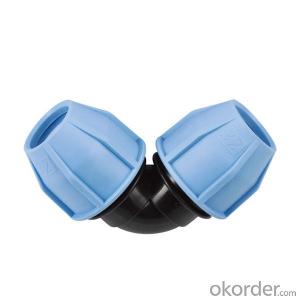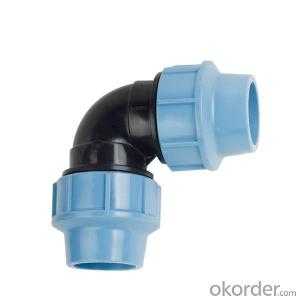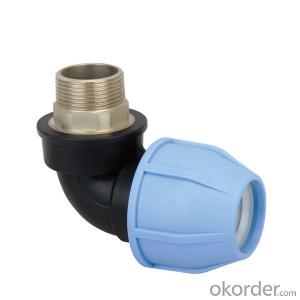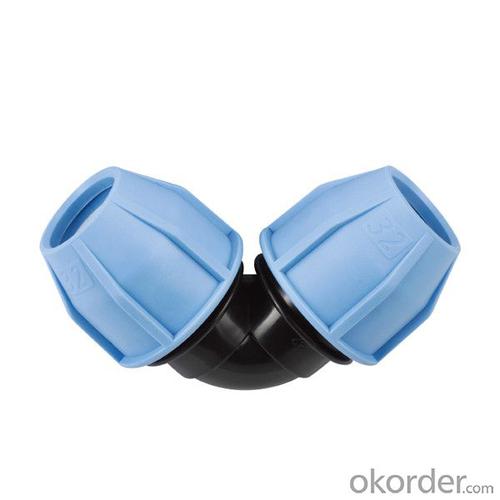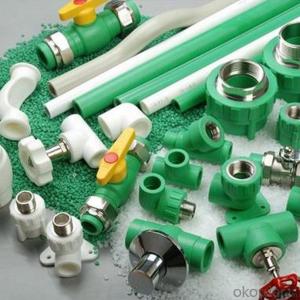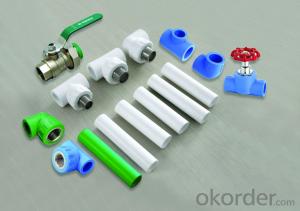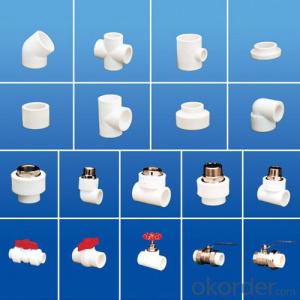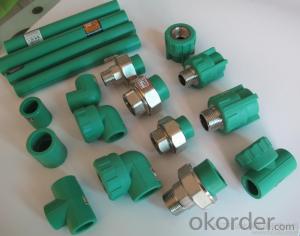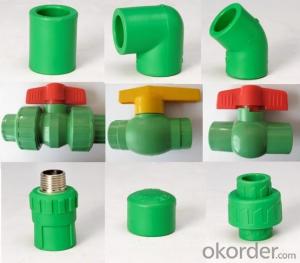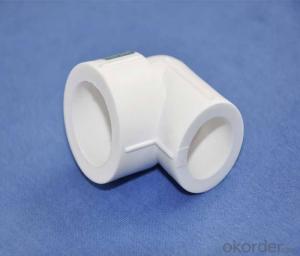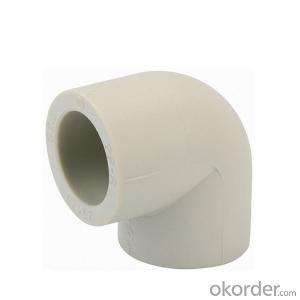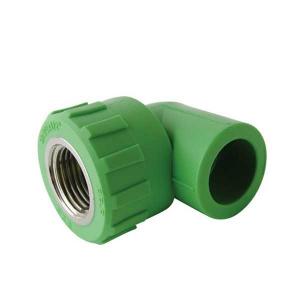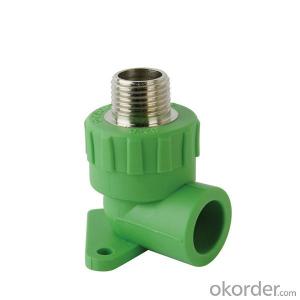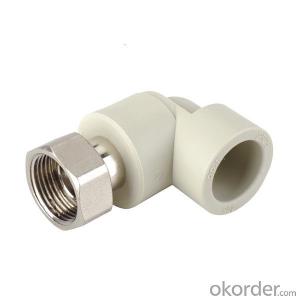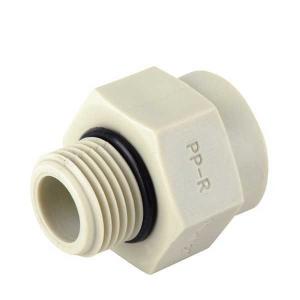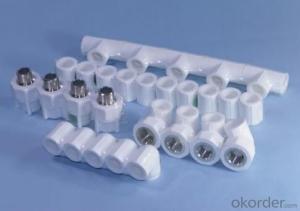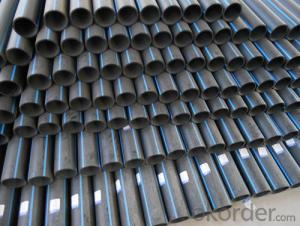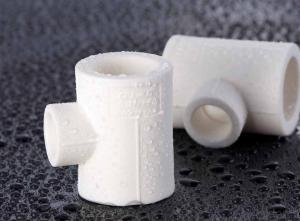Custom Plastic Pipe Fittings - China High Quality PP-R Female Threaded Elbow Fittings
- Loading Port:
- Shanghai
- Payment Terms:
- TT OR LC
- Min Order Qty:
- 1000 pc
- Supply Capability:
- 100000 pc/month
OKorder Service Pledge
OKorder Financial Service
You Might Also Like
Product Overview
1) Cold / hot water supply facilities for public buildings
2) Food, chemical, electronic industry pipeline networks; Such as Pipeline networks for transporting all kinds of corrosive liquids
3) Drinking water production system pipeline networks; Such as Pure water and mineral water
4) Air conditioning facility pipelines
5) Compressed gas pipeline networks for industry
6) Pipeline networks for swimming pools
7) Pipeline networks for solar energy facilities
8) Agriculture and garden production transporting systems
Advantanges
1, High Temperature Resistance: the maximum sustained working temperature is up to 70 Degrees Celsius, the maximum transient temperature is up to 95 Degrees Celsius.
2, Heat insulation and Saving Energy: low thermal conductivity which is only 1/1500 of brass pipe, and 1/250 of steel pipe.
Non-toxic: no heavy metal additives would not be covered with dirty or contaminated by bacterium.
3, Corrosion Resistant: resist chemical matters or electron chemical corrosion.
4, Lower Installation Costs: light weight and good hot-melt performance can reduce installation costs by as much as 50% over metal piping system.
5, Higher Flow Capacity: smooth interior walls result in lower pressure loss and higher volume than metal pipes.
6, Long Life: more than 50 years under normal conditions.
7, Recycled and Environment-friendly.
Product Description
Pressure | Size(mm) | Pressure | Size(mm) |
PN1.25MPA | 20*2.0 |
PN1.6MPA | 20*2.3 |
25*2.3 | 25*2.8 | ||
32*2.9 | 32*3.6 | ||
40*3.7 | 40*4.5 | ||
50*4.6 | 50*5.6 | ||
63*5.8 | 63*7.1 | ||
75*6.8 | 75*8.4 | ||
90*8.2 | 90*10.1 | ||
110*10.0 | 110*12.3 |
Product Show



FAQ
Q1: How Can I Get A Sample?
A1: You can get samples by communicate with our export sales.
Q2: How Long Is Delivery?
A2: Delivery time will be30-45days according to order quantity.
Q3: What Is The MOQ?
A3: MOQ depends on different items.
Q4: What Is Our Normal Payments Terms?
A4: Our normal payment terms now is: T/T, L/C or western union, pay
- Q: Can plastic pipe fittings be used for swimming pool installations?
- Yes, plastic pipe fittings can be used for swimming pool installations. They are commonly used due to their durability, resistance to corrosion, and affordability. However, it is important to ensure that the fittings are specifically designed for swimming pool use and are compatible with the type of plumbing system being used.
- Q: Are plastic pipe fittings cost-effective?
- Yes, plastic pipe fittings are generally considered cost-effective due to their low initial cost, durability, and long lifespan. They also require minimal maintenance and offer excellent resistance to corrosion, making them a reliable and affordable choice for various plumbing and piping applications.
- Q: Are plastic pipe fittings suitable for use in power plants?
- Yes, plastic pipe fittings can be suitable for use in power plants depending on the specific application and requirements. However, it is important to consider factors such as temperature, pressure, chemical compatibility, and fire resistance to ensure that the chosen plastic pipe fittings meet the necessary standards and regulations for power plant operations.
- Q: Are plastic pipe fittings suitable for industrial cooling towers?
- Yes, plastic pipe fittings are suitable for industrial cooling towers. They provide excellent corrosion resistance, durability, and cost-effectiveness, making them a popular choice in cooling tower applications. Additionally, plastic pipe fittings offer easy installation and maintenance, making them a practical solution for industrial cooling systems.
- Q: Can plastic pipe fittings be used for radiant heating systems?
- Yes, plastic pipe fittings can be used for radiant heating systems. Plastic fittings are commonly used in these systems due to their durability, flexibility, and resistance to corrosion. Additionally, plastic fittings are easier to install and can provide better insulation compared to metal fittings.
- Q: Are the elbow and three - pipe fittings installed in the water supply and drainage pipes included?
- Indoor heating plastic pipe, aluminum-plastic composite pipe, stainless steel pipe, copper pipe installation project, the pipeline joint parts as materials, according to design drawings to determine the number and loss of 1% of the cost of materials shall be calculated separately.
- Q: Can plastic pipe fittings be used for pneumatic systems?
- Yes, plastic pipe fittings can be used for pneumatic systems. Plastic fittings are often used in pneumatic systems due to their lightweight, corrosion resistance, and ease of installation. However, it is important to ensure that the plastic fittings are compatible with the specific pressure and temperature requirements of the pneumatic system to ensure safe and efficient operation.
- Q: Do plastic pipe fittings require regular maintenance?
- No, plastic pipe fittings generally do not require regular maintenance.
- Q: Can plastic pipe fittings be used for solar water heating systems?
- Yes, plastic pipe fittings can be used for solar water heating systems. Plastic pipes and fittings are often used in these systems due to their affordability, durability, and resistance to corrosion. However, it is important to ensure that the plastic materials used are compatible with the high temperatures and pressures involved in solar water heating systems.
- Q: Can plastic pipe fittings be used for swimming pool filtration?
- Yes, plastic pipe fittings can be used for swimming pool filtration. Plastic pipe fittings are commonly used in swimming pool filtration systems due to their durability, resistance to corrosion, and affordability. They are capable of handling the water flow and pressure required for efficient filtration, making them a suitable choice for this purpose.
Send your message to us
Custom Plastic Pipe Fittings - China High Quality PP-R Female Threaded Elbow Fittings
- Loading Port:
- Shanghai
- Payment Terms:
- TT OR LC
- Min Order Qty:
- 1000 pc
- Supply Capability:
- 100000 pc/month
OKorder Service Pledge
OKorder Financial Service
Similar products
Hot products
Hot Searches
Related keywords
